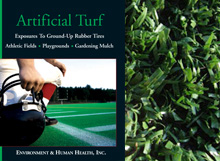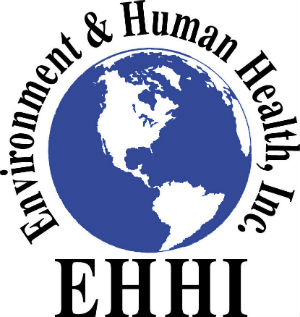EHHI's report on artificial turf calls attention to growing concerns about children’s
exposures to ground-up rubber tires used as infill material in synthetic turf fields. Crumb rubber is used in artificial turf and as playground mulch, despite potential health hazards, especially under high temperatures.
Natural grass fields get a few degrees hotter than the outside air, but synthetic turf fields get 60 to 70 degrees hotter than the outside air. This excess heat makes these fields potentially very dangerous. Athletes can get dehydrated and even suffer heat stroke while playing on them. Small children are even at a higher risk.
The chemical analysis conducted at Yale University (see below) found 12 carcinogens in the synthetic turf tested. High temperatures cause crumb rubber infill to outgas at a higher rate, which also poses an additional health risk to those who play on these fields in the summer.
In 2009, University of Washington assistant soccer coach Amy Griffin noticed abnormally high rates of cancer in athletes who played on synthetic turf. As of April 2016, she had counted 220 athletes with cancer. Of the 166 soccer players with cancer, 102 of them, or 61%, were goalkeepers. The only athletes in this informal count were those who knew to call Amy Griffin. There is still no government agency tracking cancers among athletes who have played on synthetic turf.
There were 96 chemicals found in 14 samples analyzed, half of which have had no government
testing.
Metal analysis conducted at Yale University on synthetic turf crumb rubber infill and playground rubber mulch
The metal analysis conducted at Yale University shows that metals are present in crumb rubber.
Human Health Risk Assessment of Artificial Turf Fields Based Upon Results from Five Fields in Connecticut.
Because the synthetic turf industry has claimed that the CT Department of Health study shows that synthetic turf fields were safe, Environment and Human Health, Inc., felt it important to closely analyze the actual study to see what it really said. The study only looked at the health risks to those 12 years and up—yet many younger children also play on these fields. On careful reading, you will see the flaws in the study and all their stated limitations. It is hard to believe that the researchers could declare that their data showed the fields were safe.
Read EHHI's analysis here. There Is No Safer Playing Field for Student Athletes than Grass
The OpEd by EHHI President Nancy Alderman, published in The New Haven Register, says grass is known to be safe.
"Artificial Turf: A Consumer Guide to Keeping Your Child Safe"
Summer is here and the temperatures are rising! Did you know that artificial turf can get up to 55°F higher than grass, and has been recorded as high as 200°F on a summer day? Scientists at Mt. Sinai's Children's Environmental Health Center recommend ways to keep you and your family safe.
"Pelletgate" holds up Pittsburgh Steelers-Buffalo Bills game
The game was delayed for around seven minutes, and was quickly dubbed "pelletgate" on social media. Batavia Turf Instant Lawns owner Craig Yunker says artificial fields produce hazardous waste, and the incident raised concerns about player safety.
The US EPA recommended using scrap tires on fields and playgrounds where children play.
See pages 7-10 for EPA's plan for recycling rubber tires in toddler playgrounds and synthetic
turf fields.
How the Synthetic Turf Industry is Bypassing Children's Safety
EHHI President Nancy Alderman's OpEd Published in The Hill
City of Hartford Bans Crumb Rubber Infill on Synthetic Turf Fields
Read more about the City of Hartford's ban, effective January 19, 2016.
New Jersey lawmakers Call for Fraud Investigation and Lawsuit Against FieldTurf
Company aggressively marketed defective artificial sports fields and misled schools and municipalities.
Amsterdam Says No to Rubber Granules in Artificial Turf
The tire industry association VACO's analysis found carcinogenic substances above consumer limits in 58 out of 60 artificial turf fields studied.
Hazardous organic chemicals in rubber recycled tire playgrounds and pavers
Spanish researchers investigated hazardous chemicals in surfaces containing recycled rubber
tires.
North Carolina Dept. of Ag reports potential hazards to plants from ground-up rubber
The State of Connecticut downplayed potential risks to children from crumb rubber.
An open letter on the dangers of synthetic turf from the physicians of EHHI
Italian Study Warns Synthetic Turf Fields in Italy Are Potentially Cancer-Causing, Urges Clean-Up
Swedish Study Recommends Avoiding Rubber Granules from Recycled Tires
On Playing Fields, Grass Is an Endangered Species
Artificial Turf Heat Issues
Artificial fields are largely unusable during warm days because of high temperatures. Practicing on an artificial field may increase the incidence of heat stroke, muscle cramping, and overall athlete fatigue. Scientists at Columbia University who analyzed satellite thermal images of New York City the past two summers concluded that synthetic turf fields were up to 60 degrees hotter than grass fields.
Outside Air is 98 Degrees, But Synthetic Turf Fields Reach Temperatures of 173 to 199 degrees
The Artificial Turf at the Women’s World Cup Was Reportedly 120 Degrees at Kick Off
High Temps On Turf Fields Spark Safety Concerns

